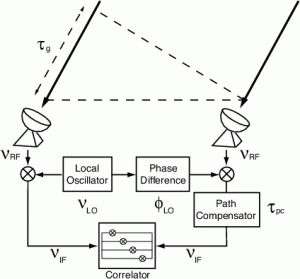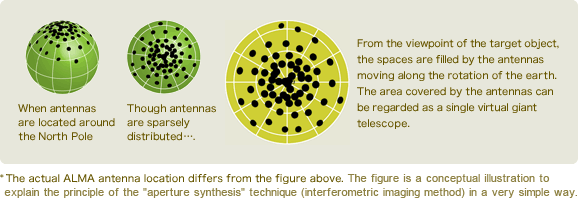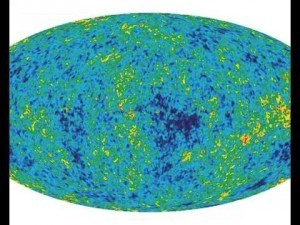One of the more powerful techniques of radio astronomy is the use of interferometry to combine the signals of several radio antennas into a single virtual telescope. Through interferometry we can make radio images with resolutions greater than that of the Hubble telescope. But how does interferometry work?
At a basic level, interferometry is simply the combining of signals from two different sources. If the two signals are similar they will combine to make a stronger signal, and if they aren’t they will tend to cancel out. Where this becomes useful for astronomy is that if two signals are out of sync you can shift them (correlate them) so that they are in sync. When the signal is strongest you know they are lined up.
When two radio antennas are aimed in the same direction, they receive the same basic signal, but the signals are out of sync because it takes a bit longer to reach one antenna than the other. That difference depends on the direction of the antennas and their spacing apart from each other. By correlating the two signals, you can determine location of the signal in the sky very precisely. It’s the precision that you need to create a high resolution image.
Two antennas only give you one point in the sky, but with dozens of antennas (such as the array at ALMA) you can get lots of points, one for each paring of antennas. But even that only gets you a discrete set of image points. If the Earth were fixed in relation to the sky, then our radio image would look like a pointillist painting.
But the Earth rotates with respect to the sky, so as time goes by the relative positions of the antennas shift with respect to an astronomical signal. As you make observations over time, the gaps between antennas are filled to create a more solid image. This isn’t easy to do. It takes lots of observations and lots of computing power to combine the images in the right way. At ALMA, for example, it takes a custom built supercomputer that spends all its time correlating signals.
But the results are nothing short of spectacular.














Comments
Hee! I wrote my junior high school science report on interferometry, and I drew a diagram like that schematic except more detailed. They were building the first ones, and I read about it in the NY Times.
So is ALMA the radio telescopes which Wright and Boyajian want to use to look for a Dyson Sphere around KIC 8462852? LOL, we can only be so lucky that it’s a Dyson Sphere at a mere 1500 LYs away from us. But even if not aliens, anything which would dim a star by 22% is still fascinating!
Though… a Kardashev Type II, man. That would take the cake!